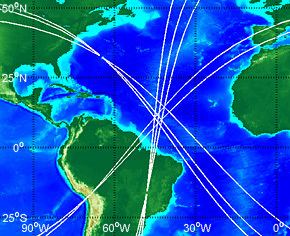Discovery date 1 January 2014 Minor planet category Apollo, NEO Discovered 1 January 2014 Asteroid group Apollo asteroid | MPC designation 2014 AA Observation arc ~70 minutes | |
 | ||
Discovered by Richard KowalskiMount Lemmon Survey (G96) Aphelion 1.4080 AU (210.63 Gm) (Q) Similar 2008 TC3, 1972 Great Daylight Fireball, 2014 DX110, 2014 RC, 2014 OL339 | ||
Asteroid 2014 aa hits earth
2014 AA was a small Apollo near-Earth asteroid roughly 2–4 meters in diameter that struck Earth on 2 January 2014. It was discovered on 1 January 2014 by Richard Kowalski at the Mount Lemmon Survey at an apparent magnitude of 19 using a 1.52-meter (60 in) reflecting telescope at Mount Lemmon Observatory. 2014 AA was only observed over a short observation arc of about 70 minutes, and entered Earth's atmosphere about 21 hours after discovery.
Contents
First 2014 asteroid discovered 2014 aa
Entry
Using a poorly determined orbit, the JPL Small-Body Database listed a 3-sigma solution with impact occurring around 2 January 2014 02:33 UT ± 1 hour and 5 minutes. The Minor Planet Center listed impact as occurring around 2 January 2014 05:00 UT ± 10 hours. Independent calculations by Bill Gray, the Minor Planet Center and Steve Chesley at the Jet Propulsion Laboratory have verified that impact was virtually certain.
The impactor would have been roughly the size of 2008 TC3, which exploded above the Nubian Desert in Sudan on 7 October 2008. Calculations by Chesley suggest the impactor fell somewhere on an arc extending from Central America to East Africa, with a best-fit location just off the coast of West Africa. Calculations by Pasquale Tricarico using the nominal orbit show that 2014 AA entered Earth's shadow cone approximately 40 minutes before entering the atmosphere.
Infrasound was detected by three stations of the Comprehensive Nuclear-Test-Ban Treaty Organization. Peter Brown and Petrus Jenniskens located weak signals from infrasound stations in Bolivia, Brazil and Bermuda. 2014 AA entered Earth's atmosphere around 04:02 UT 3,000 km from Caracas, Venezuela, far from any landmass. No ships or planes have reported witnessing the event. A recalculation of the impact parameters of this meteor based on infrasound recordings gives a longitude of impact of nearly 44º West and a latitude of 11º North, the impact time being 2456659.618 JD UTC. Extensive numerical simulations indicate that, prior to impact, 2014 AA was subjected to a number of secular resonances and it may have followed a path similar to those of the NEOs 2011 GJ3, 2011 JV10, 2012 DJ54, and 2013 NJ4; NEOs in this transient group experience close encounters with the Earth-Moon system at perihelion and Mars at aphelion and could be a dynamical family.
Kowalski previously discovered 2008 TC3, the first asteroid discovered before Earth impact, using the same telescope in October 2008. There are about a billion near-Earth objects in the size range of 2014 AA, and impacts of comparably-sized objects occur several times each year.
